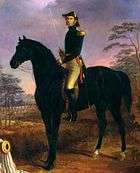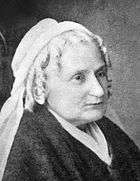Bremo Historic District
Bremo, also known as Bremo Plantation or Bremo Historic District, is a plantation estate covering over 1,500 acres (610 ha) on the west side of Bremo Bluff in Fluvanna County, Virginia. The plantation includes three separate estates, all created in the 19th century by the planter, soldier, and reformer John Hartwell Cocke on his family's 1725 land grant. The large neo-palladian mansion at "Upper" Bremo was designed by Cocke in consultation with John Neilson, a master joiner for Thomas Jefferson's Monticello. The Historic District also includes two smaller residences known as Lower Bremo and Bremo Recess.[1]
Bremo Historic District | |
.jpg) Plantation mansion at Upper Bremo, HABS photo, 1933 | |
 | |
| Location | Bremo Bluff, Virginia |
|---|---|
| Coordinates | 37.72542°N 78.32973°W |
| Area | 1,500 acres (6.1 km2) |
| Built | 1725 (Lower Bremo) 1812 (Bremo Recess) 1819 (Bremo Mansion) |
| Architect | John Hartwell Cocke Thomas Jefferson John Neilson (c.1770 - 1827) |
| Architectural style | Jacobean (Lower Bremo and Bremo Recess) Palladian (Bremo Mansion) |
| NRHP reference No. | 69000241 |
| VLR No. | 032-0002 |
| Significant dates | |
| Added to NRHP | November 12, 1969[1] |
| Designated NHLD | November 11, 1971[2] |
| Designated VLR | September 9, 1969[3] |
The plantation, which overlooks the James River,[4] was added to the National Register of Historic Places in 1969 and declared a National Historic Landmark in 1971 for its significance as a well-preserved example of Jeffersonian archicture.[2][1]
History
Starting in 1808, John Hartwell Cocke built an estate of three houses along the James River, which he named "Bremo" after his family's ancestral home of Braemore in Scotland.[5] One of the original structures was an ancestral hunting lodge at Lower Bremo that was built of stone and dated back to 1725. Cocke inhabited this lodge close to the river as his first home on the estate.[6]
Around 1812, Cocke completed a larger home for himself and his wife Anne Blaws Barraud at Bremo Recess, situated on higher ground farther back from the James River. This house featured dormer windows, a pointed roof,[7] and later incorporated elements of Jacobean architecture.[1] Anne died in December 1816 and was buried at Bremo Recess, where her ghost has reportedly been sighted wandering in the house.[8]
Construction of the mansion
During his time at Lower Bremo and Bremo Recess, Cocke began working on the design of a grand plantation mansion to be built at the Upper Bremo area. Cocke spared no expense during the construction, utilizing hand-molded brick. Even the neighboring barn was adorned with columns. The construction of the mansion took several years and was completed in 1819.[6] At about the same time, the lodge at Lower Bremo was renovated for Cocke's son Cary.[1]
Civil War years
During the American Civil War, Mary Anna Custis Lee, the wife of Confederate General Robert E. Lee, stayed at Bremo as a guest of the Cocke family. Though it was 80 miles (130 km) away from her home in Richmond, Virginia, the James River and Kanawha Canal permitted a relatively comfortable trip by boat. Bremo also did not suffer the wartime shortages that had been plaguing Richmond.[9] However, within a few days of her arrival, Lee's health suffered a setback because of a severe fall from her crutches on the finely polished floor.[10] Family friend Doctor Cary Charles Cocke built a special bed to accommodate her affliction from rheumatoid arthritis. She was usually accompanied by her son Rob and daughters Agnes and Mildred.[11]
Bremo itself did not escape the effect of the war. On March 8, 1865, the estate was raided by Union forces. General Lee personally visited the plantation that year.[12] The Lees stayed intermittently at Bremo until November 1865, after the war. The place that was occupied by Mary Anna Custis Lee is still called "Mrs. Lee’s room".[11]
Architecture
The overall design of the mansion was initiated by John Hartwell Cocke with master builder John Neilson (c.1770 - 1827), who had worked with Thomas Jefferson on Monticello. The architecture is believed to be based on the Palladian style utilized by Jefferson.[13] Although the original plans were destroyed in a fire in 1894, students of Jeffersonian architecture who had seen the drawings said that they had recognized them as the work of Jefferson himself. It has been called "the most magnificent conception of a house" in America.[6]
The mansion is one story high at its northern entrance, but has two stories on the southern side where the land slopes down towards the James River. The home is designed with distinct elements of Jeffersonian architecture, such as upper windows built at floor level to reduce the visual scale of the structure. The landscaping incorporates ha-has, which were dug out of the view from the mansion while serving to keep livestock from wandering into the yard.[14]
A monument on the estate, named Temperance Spring, is an early example, in miniature, of the Greek Revival style. The homes at Lower Bremo and Bremo Recess were rebuilt in their present Jacobean forms in 1844.[1]
See also
References
- Morton III, W. B. (August 21, 1971). "National Register of Historic Places: Inventory – Nomination Form (Bremo Historic District)". National Park Service. Retrieved April 12, 2008.
- "Bremo Historic District". National Historic Landmarks Program. National Park Service. November 11, 1971. Archived from the original on December 26, 2007. Retrieved April 12, 2008.
- "Virginia Landmarks Register". Virginia Department of Historic Resources. Archived from the original on 2013-09-21. Retrieved 2013-03-12.
- "Map 032-0002 of Bremo Plantation Historic District" (PDF). Virginia Department of Historic Resources. February 22, 2007. Archived from the original (PDF) on May 11, 2008. Retrieved April 12, 2008.
- Browning, Sally (February 26, 2004). "Bremo Bluff: From Beginning to End". Fluvanna Review. Archived from the original on November 30, 2012. Retrieved December 4, 2010.CS1 maint: BOT: original-url status unknown (link)
- Johnston, Clara Cocke (1931). "Bremo". Homes and Gardens in Old Virginia: 127–132. Archived from the original on March 2006. Retrieved December 7, 2010.
- Johnston, Clara Cocke (1931). "Bremo Recess". Homes and Gardens in Old Virginia: 125–127. Archived from the original on March 2006. Retrieved December 7, 2010.
- Sancken, Kristin (October 27, 2010). "Ghostly Legends of Fluvanna County". Fluvanna Review. Retrieved December 14, 2010.
- Perry, John (2003). Mrs. Robert E. Lee: The Lady of Arlington. Random House. ISBN 978-1-59052-137-3. Retrieved December 8, 2010.
- Thompson, Mary V. (August 22, 2006). "Statements by Washington/Custis Family Members Concerning Religion, God, Life, Death, Charity, and Morality" (PDF). The Mount Vernon Ladies' Association. Archived from the original (PDF) on August 4, 2010. Retrieved December 6, 2010.
- Holen, O.T. (June 26, 2008). "Mrs. Robert E. Lee's Visit(s) to Bremo Bluff". Fluvanna Review. Retrieved December 4, 2010.
- "Mount Pleasant Timeline". The Mount Pleasant Foundation. Archived from the original on July 14, 2011. Retrieved December 8, 2010.
- Loth, Calder (1999). "Fluvanna County". The Virginia Landmarks Register. University of Virginia Press: 172. ISBN 978-0-8139-1862-4. Retrieved December 3, 2010.
- Lay, K. Edward (2000). The Architecture of Jefferson Country. University of Virginia Press. p. 98. ISBN 978-0-8139-1885-3. Retrieved December 14, 2010.
- Chiat, Marilyn Joyce Segal (1997). "Bremo Slave Chapel". America's Religious Architecture: Sacred Places for Every Community. New York City: John Wiley & Sons: 237. ISBN 978-0-471-14502-8. Retrieved December 3, 2010.
Further reading
- Kimball, Fiske (January 1949). "The Building of Bremo". The Virginia Magazine of History and Biography. 57 (1): 43.
- Gaines Jr., William H. (Autumn 1956). "A Home Dedicated to Service". Virginia Cavalcade. 6 (2): 20–29.
- Waterman, Thomas T. (1945). The Mansions of Virginia. New York. p. 45.
External links
| Wikimedia Commons has media related to Bremo Plantation. |
- Historic American Buildings Survey (HABS) No. VA-302, "Bremo, State Route 656 vicinity, Bremo Bluff, Fluvanna County, VA", 29 photos, 3 data pages, supplemental material
- National Register Nomination form and photo at the Virginia Department of Historic Resources
- National Historic Landmarks Survey photos: Bremo Historic District at the National Park Service
- Bremo at the Historical Marker Database



